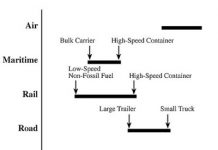by Debra Fiakas CFA
Gas-to-liquids is back on my radar screen after an article appearing in early March 2015 on Biofuels Digest described progress Emerging Fuels Technology (EFT) has made in perfecting the Fischer-Tropsch process to convert carbon-based feedstock to liquid fuel, otherwise called Gas-to-Liquids.
Fischer-Tropsch often referred to as FT for short is a series of chemical reactions to convert carbon monoxide and hydrogen into liquid hydrocarbons. The reactions are triggered by a catalyst, usually cobalt or iron, and managed under high temperatures in a chamber or reactor. Some might consider it a neat trick to converting otherwise useless waste biomass or stranded natural gas to something useful like a liquid transportation fuel. The problem is that FT is expensive, requiring significant capital to build the reactor and attendant gasification, water handling, and fuel distribution systems. Operating costs are also steep for catalyst materials, operating personnel, maintenance.
Plenty of developers have tried and failed to commercialize FT. The last post ‘A Second Look at Gas-to-Liquids’ mentioned Rentech (RTK: Nasdaq), which exited the gas-to-liquids development race a couple of years ago. Rentech voluntarily threw in the towel, but Germany-based Choren Industries was forced into bankruptcy as development costs and construction delays burned up capital resources. While that post made a nice trip down memory lane, turning over the shards of failure and loss, I really want to bring to investors’ attention new investment ideas of companies that are making a success of gas-to-liquids technologies.
Linc Energy (LNCGY: OTC/PK, T16: SGX) in Australia is combining its expertise in the gasification of underground coal deposits with gas-to-liquids technologies to produce synthetic crude oil. The company is producing one million cubic meters of syngas from an underground coal deposit at a facility near Angren, Uzbekistan. The syngas is used for electricity generation at an adjacent power plant. Linc has demonstrated at a plant in Australia that its syngas can be converted to liquid fuel using a Fischer-Tropsch process. A demonstration facility in Australia has proven five different coal gasifiers as well as a gas-to-liquids pilot system. Linc Energy’s CEO has demonstrated its diesel output in a trip around Australia in 2011 and a second trip in 2012 demonstrating its jet fuel output.
As impressive as those two trips might have been, Linc Energy has yet to earn revenue from the sale of liquid fuels. What is more its gasification technologies are not yet its bread and butter. In the year 2014, over 95% of revenue was provided by the sale of gas in the US derived from conventional oil and gas operations. The sale of syngas in Uzbekistan accounted for 1.8% of sales.
Linc Energy reported AUS$148.4 million (US$112.8 million) in total sales in the year 2014, on which it experienced a total loss of AUS$229.5 million (US$174.4 million). Gross profit was a slim 24.3%, down from a profit margin of 52.1% in the previous year. The company used AUS$32.6 million (US$24.8 million) in cash during the year, putting some pressure on cash resources. The company held AUS$48.7 million (US$37.0 million) in cash at the end of the December 2014, down dramatically from a year earlier when there was AUS$124.0 million (US$94.2 million) in the bank.
Understandably Linc Energy’s stock price reflects the red ink across the company’s financial reports. The quotation for the stock on the U.S. Over-the-Counter service has come down by 48% since the beginning of December 2014. Until the company announces some sort of fundamental accomplishment, it is not likely the stock will reverse the current weak trend. On the other hand the contrarian investor who is tolerated of considerable risk could find encouragement in Linc Energy’s demonstration of gas-to-liquid diesel and jet fuel and regard the relatively lower price for LNCGY as a good opportunity to buy on the cheap.
Debra Fiakas is the Managing Director of Crystal Equity Research, an alternative research resource on small capitalization companies in selected industries.
Neither the author of the Small Cap Strategist web log, Crystal Equity Research nor its affiliates have a beneficial interest in the companies mentioned herein.







